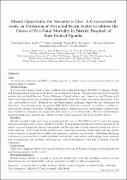| dc.contributor.author | Waako, Christopher Knox | |
| dc.contributor.author | Nanyingi, Miisa | |
| dc.contributor.author | Katongole, Simon Peter | |
| dc.contributor.author | Atuhairwe, Christine | |
| dc.contributor.author | Konso, Jennipher Mariam | |
| dc.contributor.author | Maniple, Everd | |
| dc.date.accessioned | 2023-05-18T15:53:47Z | |
| dc.date.available | 2023-05-18T15:53:47Z | |
| dc.date.issued | 2022-09-10 | |
| dc.identifier.citation | Waako, C.K., Nanyingi, M., Katongole, S.P., Atuhairwe, C., Konso, J.M. and Maniple, E., 2022. Missed Opportunity for Neonates to Live: A Cross-sectional study on Utilization of Peri-natal Death Audits to address the Causes of Peri-Natal Mortality in District Hospitals of East–Central Uganda. Student's Journal of Health Research Africa, 3(9), pp.18-18. | en_US |
| dc.identifier.issn | 2709-9997 | |
| dc.identifier.uri | http://hdl.handle.net/20.500.12280/3016 | |
| dc.description.abstract | Aim:
To assess the utilization of PDAs in addressing the avoidable causes of perinatal mortality in the
eastern region of Uganda.
Methodology:
A cross-section design using a mixed method was conducted between 2014-2015 at Iganga, Bugiri,
and Kamuli general hospitals in the East-Central region of Uganda. The interviews involved 115 health
workers who included Doctors, Nurses/Midwives, Clinical officers, and Laboratory and Theatre staff.
These were drawn from four departments including the Maternity ward, Outpatient department, Theatre,
and paediatric ward. Hospital top and departmental managers formed the key informants for
this study. Annual reports for the period 2009/10-2012/13 were reviewed. In addition, monthly reports
for the calendar year 2013 together with patients’ clinical case notes and patients’ registers were
also reviewed to determine the magnitude and causes of perinatal mortality. Factors contributing to
perinatal death were assessed and categorized into foetal, maternal, and health facility factors.
Results:
Results revealed a high and rising perinatal mortality rate of 70/1,000 live births and a decreasing
maternal mortality ratio of 363/100,000 live births. Most perinatal deaths were fresh stillbirths 48/88
which occurred during the intrapartum period and the majority of early neonatal death was due to
birth asphyxia. None of the health facilities was conducting perinatal death audits and the quality
of data used for perinatal death audits was inadequate and was scored poorly. Challenges hindering
utilization of perinatal death audits included: lack of staff sensitization and training, work overload,
lack of motivation, fear of blame and litigation, political interference, and lack of support from the
community.
Conclusion:
There was a high prevalence of perinatal deaths in east-central Uganda yet none of the hospitals was
conducting perinatal death reviews.
Recommendations:
Health workers should be trained on perinatal death audit tools and guidelines and the records
departments are revitalized with tools and personnel for effective data management. | en_US |
| dc.language.iso | en_US | en_US |
| dc.publisher | Students journal of health research Africa | en_US |
| dc.subject | perinatal deaths audits | en_US |
| dc.subject | maternal deaths | en_US |
| dc.subject | Eastern Uganda | en_US |
| dc.subject | neonatal deaths | en_US |
| dc.subject | stillbirths | en_US |
| dc.title | Missed Opportunity for Neonates to Live: A Cross-sectional study on Utilization of Peri-natal Death Audits to address the Causes of Peri-Natal Mortality in District Hospitals of East–Central Uganda. | en_US |
| dc.type | Article | en_US |


